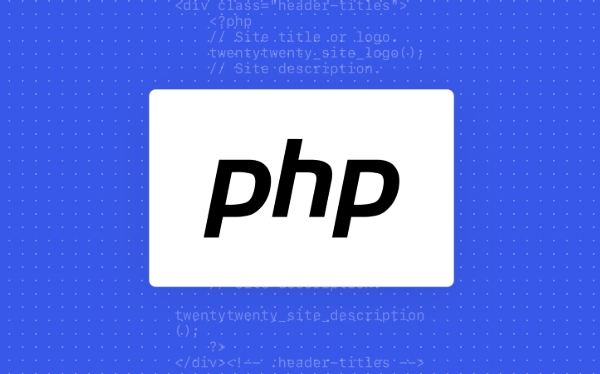Yes, you can install PHP on macOS. Installing PHP using Homebrew is the easiest and most reliable method: 1. Install Homebrew; 2. Add the shivammathur/php repository; 3. Install the specified version such as php@8.2 and link it globally. Then configure the web server to run the PHP file: macOS comes with Apache, you need to start and configure the PHP file to load the PHP module and put the PHP file into the specified directory; or select Nginx to use with PHP-FPM. Common problems include path errors that require PATH modification, permission issues are handled with chown/chmod, and the ability to install multiple PHP versions at the same time to manage through brew services. Master these steps and precautions and complete the installation smoothly.

Yes, you can absolutely install PHP on macOS — and it's not as complicated as it might sound. macOS comes with a version of PHP pre-installed (or at least used to in earlier versions), but it's often outdated or completely removed in newer releases like macOS Ventura and Sonoma. So if you want to run PHP locally for development, you'll need to install it yourself.

Here's how to do it in a way that works well and doesn't leave you guessing what went wrong.
Use Homebrew to Install PHP
Homebrew is the easiest and most reliable way to install PHP on macOS. If you don't have it yet, install Homebrew first by running this command in your terminal:

/bin/bash -c "$(curl -fsSL https://raw.githubusercontent.com/Homebrew/install/HEAD/install.sh)"
Once that's done, tap into the PHP repository:
brew tap shivammathur/php
Then install the version of PHP you want. For example, to install PHP 8.2:

brew install shivammathur/php/php@8.2
After installation, link the version so it's available globally:
brew link --force --overwrite php@8.2
You can check the installed version with:
php -v
Set Up a Web Server (Apache or Nginx)
PHP alone isn't enough — you need a web server to actually run PHP files through a browser.
Apache (built-in)
macOS comes with Apache built in. Start it with:
sudo apachectl start
Test it by going to http://localhost in your browser. You should see a message saying “It works!”
To make it serve PHP files:
- Put your
.phpfiles in/Library/WebServer/Documents/ - Make sure PHP is enabled by editing Apache's config file (
/etc/apache2/httpd.conf) and uncommenting or adding:
LoadModule php_module /usr/local/opt/php@8.2/lib/httpd/modules/libphp.so
Then restart Apache:
sudo apachectl restart
Or use Nginx
If you prefer Nginx, install it via Homebrew:
brew install nginx
Configure it to work with PHP-FPM (which also gets installed when you install PHP). The setup is slightly more involved, but there are plenty of guides online tailored for macOS.
Common Issues and Fixes
Path problems : After installing PHP, your terminal might still show the old version. Check with
which php. If it points to/usr/bin/php, update your PATH in~/.zshrcor~/.bash_profile:export PATH="/usr/local/opt/php@8.2/bin:$PATH" export PATH="/usr/local/opt/php@8.2/sbin:$PATH"
Then reload the shell:
source ~/.zshrc
Permissions : When setting up web directories, you may run into permission errors. Use
sudo chownorchmodcarefully to fix them.Multiple PHP versions : You can install multiple PHP versions side by side. Use
brew servicesto manage which one runs.
Wrap-up
Installing PHP on macOS boils down to using Homebrew, linking the right version, and pairing it with a web server. It's not hard once you know the steps, but small issues like path settings or Apache config can trip you up. Keep an eye out for those, and you'll be good to go.
Basically that's it.
The above is the detailed content of Installing PHP on macOS. For more information, please follow other related articles on the PHP Chinese website!

Hot AI Tools

Undress AI Tool
Undress images for free

Undresser.AI Undress
AI-powered app for creating realistic nude photos

AI Clothes Remover
Online AI tool for removing clothes from photos.

Clothoff.io
AI clothes remover

Video Face Swap
Swap faces in any video effortlessly with our completely free AI face swap tool!

Hot Article

Hot Tools

Notepad++7.3.1
Easy-to-use and free code editor

SublimeText3 Chinese version
Chinese version, very easy to use

Zend Studio 13.0.1
Powerful PHP integrated development environment

Dreamweaver CS6
Visual web development tools

SublimeText3 Mac version
God-level code editing software (SublimeText3)
 How to use PHP to build social sharing functions PHP sharing interface integration practice
Jul 25, 2025 pm 08:51 PM
How to use PHP to build social sharing functions PHP sharing interface integration practice
Jul 25, 2025 pm 08:51 PM
The core method of building social sharing functions in PHP is to dynamically generate sharing links that meet the requirements of each platform. 1. First get the current page or specified URL and article information; 2. Use urlencode to encode the parameters; 3. Splice and generate sharing links according to the protocols of each platform; 4. Display links on the front end for users to click and share; 5. Dynamically generate OG tags on the page to optimize sharing content display; 6. Be sure to escape user input to prevent XSS attacks. This method does not require complex authentication, has low maintenance costs, and is suitable for most content sharing needs.
 How to use PHP combined with AI to achieve text error correction PHP syntax detection and optimization
Jul 25, 2025 pm 08:57 PM
How to use PHP combined with AI to achieve text error correction PHP syntax detection and optimization
Jul 25, 2025 pm 08:57 PM
To realize text error correction and syntax optimization with AI, you need to follow the following steps: 1. Select a suitable AI model or API, such as Baidu, Tencent API or open source NLP library; 2. Call the API through PHP's curl or Guzzle and process the return results; 3. Display error correction information in the application and allow users to choose whether to adopt it; 4. Use php-l and PHP_CodeSniffer for syntax detection and code optimization; 5. Continuously collect feedback and update the model or rules to improve the effect. When choosing AIAPI, focus on evaluating accuracy, response speed, price and support for PHP. Code optimization should follow PSR specifications, use cache reasonably, avoid circular queries, review code regularly, and use X
 Beyond the LAMP Stack: PHP's Role in Modern Enterprise Architecture
Jul 27, 2025 am 04:31 AM
Beyond the LAMP Stack: PHP's Role in Modern Enterprise Architecture
Jul 27, 2025 am 04:31 AM
PHPisstillrelevantinmodernenterpriseenvironments.1.ModernPHP(7.xand8.x)offersperformancegains,stricttyping,JITcompilation,andmodernsyntax,makingitsuitableforlarge-scaleapplications.2.PHPintegrateseffectivelyinhybridarchitectures,servingasanAPIgateway
 Object-Relational Mapping (ORM) Performance Tuning in PHP
Jul 29, 2025 am 05:00 AM
Object-Relational Mapping (ORM) Performance Tuning in PHP
Jul 29, 2025 am 05:00 AM
Avoid N 1 query problems, reduce the number of database queries by loading associated data in advance; 2. Select only the required fields to avoid loading complete entities to save memory and bandwidth; 3. Use cache strategies reasonably, such as Doctrine's secondary cache or Redis cache high-frequency query results; 4. Optimize the entity life cycle and call clear() regularly to free up memory to prevent memory overflow; 5. Ensure that the database index exists and analyze the generated SQL statements to avoid inefficient queries; 6. Disable automatic change tracking in scenarios where changes are not required, and use arrays or lightweight modes to improve performance. Correct use of ORM requires combining SQL monitoring, caching, batch processing and appropriate optimization to ensure application performance while maintaining development efficiency.
 Building Resilient Microservices with PHP and RabbitMQ
Jul 27, 2025 am 04:32 AM
Building Resilient Microservices with PHP and RabbitMQ
Jul 27, 2025 am 04:32 AM
To build a flexible PHP microservice, you need to use RabbitMQ to achieve asynchronous communication, 1. Decouple the service through message queues to avoid cascade failures; 2. Configure persistent queues, persistent messages, release confirmation and manual ACK to ensure reliability; 3. Use exponential backoff retry, TTL and dead letter queue security processing failures; 4. Use tools such as supervisord to protect consumer processes and enable heartbeat mechanisms to ensure service health; and ultimately realize the ability of the system to continuously operate in failures.
 python run shell command example
Jul 26, 2025 am 07:50 AM
python run shell command example
Jul 26, 2025 am 07:50 AM
Use subprocess.run() to safely execute shell commands and capture output. It is recommended to pass parameters in lists to avoid injection risks; 2. When shell characteristics are required, you can set shell=True, but beware of command injection; 3. Use subprocess.Popen to realize real-time output processing; 4. Set check=True to throw exceptions when the command fails; 5. You can directly call chains to obtain output in a simple scenario; you should give priority to subprocess.run() in daily life to avoid using os.system() or deprecated modules. The above methods override the core usage of executing shell commands in Python.
 Creating Production-Ready Docker Environments for PHP
Jul 27, 2025 am 04:32 AM
Creating Production-Ready Docker Environments for PHP
Jul 27, 2025 am 04:32 AM
Using the correct PHP basic image and configuring a secure, performance-optimized Docker environment is the key to achieving production ready. 1. Select php:8.3-fpm-alpine as the basic image to reduce the attack surface and improve performance; 2. Disable dangerous functions through custom php.ini, turn off error display, and enable Opcache and JIT to enhance security and performance; 3. Use Nginx as the reverse proxy to restrict access to sensitive files and correctly forward PHP requests to PHP-FPM; 4. Use multi-stage optimization images to remove development dependencies, and set up non-root users to run containers; 5. Optional Supervisord to manage multiple processes such as cron; 6. Verify that no sensitive information leakage before deployment
 VSCode settings.json location
Aug 01, 2025 am 06:12 AM
VSCode settings.json location
Aug 01, 2025 am 06:12 AM
The settings.json file is located in the user-level or workspace-level path and is used to customize VSCode settings. 1. User-level path: Windows is C:\Users\\AppData\Roaming\Code\User\settings.json, macOS is /Users//Library/ApplicationSupport/Code/User/settings.json, Linux is /home//.config/Code/User/settings.json; 2. Workspace-level path: .vscode/settings in the project root directory






